Baltimore Orioles top 10 prospects for 2019
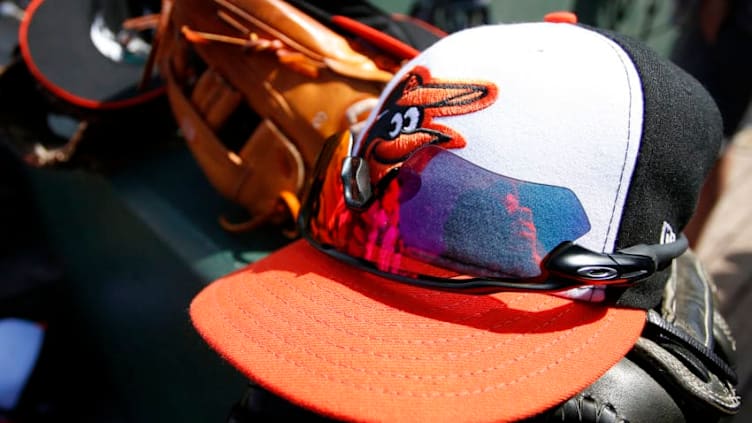
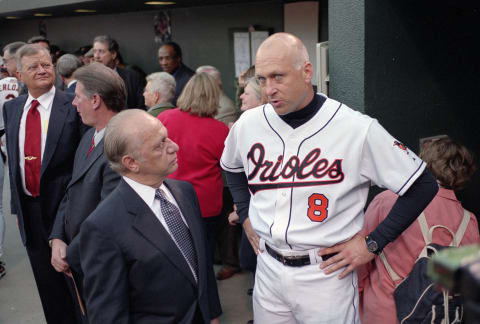
The Baltimore Orioles had a rough season in 2018. What is in the farm system to give Orioles fans hope for the future?
We are in our third offseason at Call to the Pen of putting together top 10 prospect lists for every organization in baseball. Today’s list is the Baltimore Orioles.
The Process
Our team prospect lists are compiled by Benjamin Chase, who has spent time doing plenty of watching via MiLB.tv of every organization in baseball along with talking to a very wide array of scouts who have seen players in person to hone his own opinion on players. That allows for a wide coverage on players from the Dominican Summer League all the way to the major leagues.
These lists are the opinion of Ben, and his process is heavily weighted on his own view, but also on trusted views of others. Typically, each system’s list of 10 is peeled down from a consideration list of 50-75 players. There will be some weight given to a player who is closer to the major leagues, but often these opinions will be different than some of the “major” lists out there. Feel free to comment at the end of the list with any questions you may have!
With that out of the way, let’s dig into today’s list:
Baltimore Orioles system review
Orioles list for 2017
Orioles list for 2018
Orioles 2018 minors all-stars
The Baltimore Orioles have been getting plenty of rough reviews for years on their farm system, and their lack of involvement in the international market has really led to the team having to nail the draft, which is a tall order for any scouting department.
That said, the ripping that the Orioles’ pitching development has received over the years is really a thing of the past as John Wasdin has done an excellent job building a pitching development program since taking over that role within the minor league system in 2017. Due to that, while the top of the list is position-player heavy, if this list were expanding to a top 20, much of the next 10 would be pitchers.
Let’s start with the countdown, starting with a player that fell outside of the top 10, but was picked up in 2018 via the draft or international signing and is worthy of extra attention going into 2019…
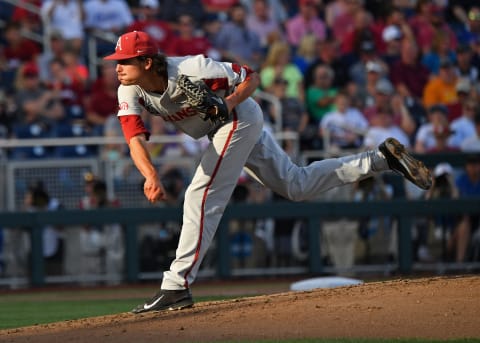
Blaine Knight, RHP
Birthday: 6/28/1996 (22)
Acquired: Draft, 3rd round, 2018
Level(s): short-season A Aberdeen
Statistics: 4 G, 10 1/3 IP, 2.61 ERA, 1.55 WHIP, 6.4% BB, 17% K
The words were clear during the College World Series broadcast in June. As Blaine Knight pitched his Arkansas Razorbacks toward a possible championship, the announcers for ESPN mentioned how unfortunate it was for Knight to go to the Baltimore Orioles with their pitching development program. Yet, for his pitching style and development needed, there may not be a better fit for Knight.
Knight is a rail-thin 6’3″ right-handed starter who has the ability to dial up his fastball to 97-98 and sit 92-95 with some very good arm side movement. He has tremendous spin on his slider and some feel for his changeup. He works in a slow curve infrequently, but has shown good feel for when to use the pitch to leave hitters completely stumped in the box.
After a long season with Arkansas and a heavy workload with the Razorbacks, the Orioles didn’t push Knight heavily in 2018, so there wasn’t a heavy look at him. He could open in low-A, but it would not surprise at all if he jumps right up to high-A to open his 2019.
10. Dillon Tate, RHP
Birthday: 5/1/1994 (24)
Acquired: Trade with NYY, 2018
Level(s): AA Bowie
Statistics: (combined with Yankees system numbers) 22 G, 123 1/3 IP, 4.16 ERA, 1.20 WHIP, 6.6% BB, 18.5% K
Originally drafted #4 overall in 2015 out of UC-Santa Barbara by the Texas Rangers, Dillon Tate is now on his third organization, which would scare a number of people away from him. Instead, there’s a reason why multiple teams want his arm in their system.
Dillon Tate can still reach mid-90s with his hard-spin fastball, and that is the reason so many teams are very interested. Tate has worked hard to simplify his delivery since being drafted. He’s also done well to polish his body on the mound, which increases his athleticism and ability to adjust in game as needed.
Tate’s biggest issue has never been his fastball. That fastball has good movement that seems to work well in the middle of the zone with his spin rate giving an appearance of rise. He does have an impressive slider as well that seems to play up the harder he throws it, oddly working better when it’s more in the 85-87 range than its normal 83-84 range.
While many saw Tate as a guy who would move quickly to the Orioles rotation, his best fit may be as a multi-inning reliever, using his fastball/slider combination and spotting in his average change to work over multiple innings of relief. He could eventually work into a late inning role as well, and he could open 2019 in the Baltimore Orioles bullpen.
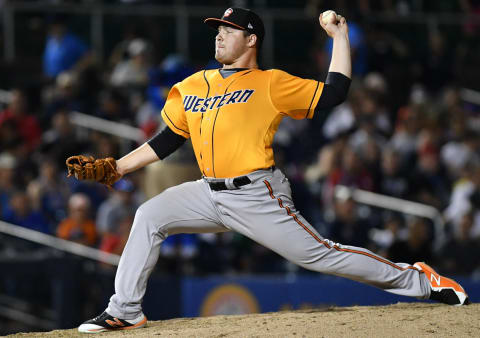
9. Keegan Akin, LHP
Birthday: 4/1/1995 (23)
Acquired: Draft, 2nd round, 2016
Level(s): AA Bowie
Statistics: 25 G, 137 2/3 IP, 3.27 ERA, 1.25 WHIP, 10.1% BB, 24.8% K
The Baltimore Orioles put a focus on college pitching starting in the 2016 draft, and getting Keegan Akin out of Western Michigan has turned into a very wise selection in the 2nd round. While his performance was very good from the get-go, many noted his average velocity.
In 2018, Akin saw a tick up in his velocity, where he could finish with a top end of 95 MPH and sit 91-93 late in games. Known for his deception, adding velocity really made squaring up his stuff difficult for hitters. That deception still presents more issues with controlling his stuff at times than you’d like, but it does keep hitters off of his pitches.
Akin works with a low-80s slider and a change that sits in the same velocity. He showed some ability to manipulate his slider to be both a short-breaking slider and a sweeping slider, though the sweeper out of his deception is most difficult to pick up and contact.
While he still projects as a back-end starter, Akin’s shown plenty of ability on the mound to pitch above his raw ability, and if he’s allowed to do so at the big league level, he could turn into a very solid mid-rotation arm. He’s going to get a shot at the rotation coming out of spring training in 2019.
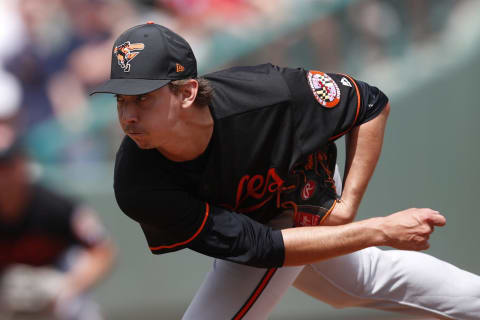
8. Hunter Harvey, RHP
Birthday: 12/9/1994 (23)
Acquired: Draft, 1st round, 2013
Level(s): AA Bowie
Statistics: 9 G, 32 1/3 IP, 5.57 ERA, 1.39 WHIP, 6.5% BB, 21.7% K
Hunter Harvey is probably nearing curse word status for Baltimore Orioles fans at this point as the young arm has been part of the organization for six seasons now and still has less than 200 innings total pitched.
The issue of course, is the 176 2/3 innings he’s thrown have been very, very good as Harvey has tremendous raw stuff, and in 2018, that stuff was still there when he was on the mound. On his stuff, the biggest issue has always been his cross-body delivery, which could hinder his command, but he does control the ball well.
The 2018 injury for Harvey was the one that could be the big issue for Harvey – a shoulder issue. While elbow issues, broken bones, and groin surgery are all bad, they’re things a pitcher can return from. Harvey will be a guy to monitor closely in 2019 as his return from shoulder injury could be the first time he’s really returning from something that gives a major worry to hindering his raw stuff on the mound.
If he can return with his same stuff, it may be time to scrap the idea of Harvey starting and move him to the bullpen. His mid-90s fastball and big curve would be impressive weapons in the bullpen, but he needs to be on the mound, even in relief, to utilize them.
7. Dean Kremer, RHP
Birthday: 1/7/1996 (22)
Acquired: Trade with LAD, 2018
Level(s): AA Bowie
Statistics: (combined with Dodgers org) 25 G, 131 1/3 IP, 2.88 ERA, 1.17 WHIP, 8.6% BB, 33.3% K
Dean Kremer was a rare California pitcher not drafted at all out of high school, but he went to UNLV and changed that, as the Dodgers drafted him in the 14th round in 2016. Kremer’s been working between the rotation and bullpen his first two years, but he took a big step forward in 2018.
Starting his season in the hitter-friendly California League, Kremer was dominant on the mound, earning a move to AA, where he struck out 11 over 7 innings in his first AA start in the Dodgers system before the Baltimore Orioles acquired him as part of the Manny Machado deal.
Kremer doesn’t use a high-velocity mix to dominate hitters, instead utilizing a good four-pitch mix keyed by a fastball that touches 95-96 and sits 91-93. His curve is at least a plus pitch and perhaps even a plus-plus pitch. However, the ability to sequence his four pitches are why he’s having success now and continued having success against upper minors hitters after his promotion, both with the Dodgers and Orioles organizations.
The jump of his performance isn’t likely to indicate Kremer is now an ace, but he certainly could be a mid-rotation arm and has moved his timeline up. The Orioles could open him in AAA in 2019 with a chance to get some major league starts by the end of the season.
6. Grayson Rodriguez, RHP
Birthday: 11/16/1999 (18)
Acquired: Draft, 1st round, 2018
Level(s): GCL Orioles
Statistics: 9 G, 8 GS, 19 1/3 IP, 1.40 ERA, 1.24 WHIP, 8.8% BB, 25% K
One of the big risers on spring draft boards was 6’5″ Texas high school righty Grayson Rodriguez. This came after Rodriguez showed up to spring ball after adding 15-25 pounds (depending on who you believe) of muscle to his frame and was able to maintain his stuff later into starts.
Grayson is known for his movement on his mid-90s fastball that can touch 97-98. The high arm slot he has makes a horizontal breaking pitch a challenge, but his big curve fits well into that arm slot. The added muscle came with plenty of toning in his body, allowing him to be much more athletic on the mound and that has seen his arm slot be more consistent.
Right now, most see Rodriguez as a mid-rotation starter with a fairly safe floor, as safe as a high school pitcher can be. His increased athleticism, however, has him working better off the mound defensively and had him working with a few different looks on pitches in the complex.
I’m personally a big fan of the split-finger, whether as a fastball offering or as a changeup variety, but either way, with Grayson’s high arm slot and balance of other pitches, the split would seem a natural fit for him and could lead to even more ceiling to his already-potent mix of pitches.
Rodriguez should get his first look at low-A in 2019, whether he opens the season there or heads there after a short time in extended spring.
5. Austin Hays, OF
Birthday: 7/5/1995 (23)
Acquired: Draft, 3rd round, 2016
Level(s): short-season A-ball Aberdeen, AA Bowie
Statistics: .235/.266/.410, 75 G, 327 PA, 14 2B, 2 3B, 12 HR, 6 SB, 4.3% BB, 20.2% K
The 2018 season of Austin Hays was a great example of what can happen when a hitter has a bit too much success too soon! After coasting his way up to the major leagues in 2017, hitting .329 with 32 home runs in the minors in his first full season in the organization, Hays suffered big setbacks via injury and performance in 2018.
While the injuries could not be adjusted for, Hays’ swing changed drastically in 2018, and that led to a lot of the struggles he saw. To his credit, his impressive bat speed kept his strikeout rate quite reasonable, but rather than using the whole field the way he had as an amateur and in his first minor league season, Hays got pull-happy and tried to yank every pitch to left field.
Coming out of the 2017 season, the profile to write on Hays was that his biggest development left was simply letting pitches go, as his aggressive all-fields approach was led by a very adept contact ability that allowed him to hit well and keep his strikeouts low, but it also led to a fairly low walk rate. Otherwise, his overall skill base was that of a prototype right fielder.
Hays will likely open 2019 back in Bowie, with a quick trigger up to AAA and the majors as his advanced hitting skills could be useful in a lineup of three true outcome hitters. Defensively, he and projected Baltimore Orioles starting center fielder Cedric Mullins played very well together in the outfield, and they could be spending plenty of 2019 together in the outfield as well.
4. Ryan McKenna, OF
Birthday: 2/14/1997 (21)
Acquired: Draft, 4th round, 2015
Level(s): high-A Frederick, AA Bowie
Statistics: .315/.410/.457, 127 G, 551 PA, 25 2B, 4 3B, 11 HR, 9 SB, 12% BB, 18.3% K
Originally drafted out of high school in New Hampshire, Ryan McKenna is not exactly a physically intimidating player, standing just 5’11” and listed at 185 pounds, though both numbers seem on the exaggerated side. After struggling his way to high-A Frederick, however, he had a huge breakout in 2018.
McKenna doesn’t profile as a guy who will ever hit 30 home runs or even likely steal 30 bases. While he’s a very smart baserunner, he’s not a natural base stealer, so while he can hone that skill as he works his way up the farm system, McKenna’s going to likely be more valuable going 1st to 3rd on a single than 1st to 2nd on a slider right now.
In center field, McKenna’s above-average straight line speed allows him to handle everything, and he does get good reads off of the bat, but he’s likely going to end up shifting to a corner down the road, most likely left field.
McKenna did struggle some after his promotion to AA this year, but much of my views showed a player who simply was fatigued, and his performance in the Arizona Fall League has shown that his high-A performance was no flash in the pan.
Most likely, McKenna will open at AA in 2019, but he has the profile of a modern leadoff guy, with excellent contact skills, the ability to take a walk, gap power, and excellent base running skills. He could move up quickly to a Baltimore Orioles team in need of a leadoff man if he’s able to handle AA and then AAA well.
3. Ryan Mountcastle, 3B
Birthday: 2/18/1997 (21)
Acquired: Draft, 1st round, 2015
Level(s): AA Bowie
Statistics: .297/.341/.464, 102 G, 428 PA, 19 2B, 4 3B, 13 HR, 2 SB, 6.1% BB, 18.5% K
The Baltimore Orioles first-round selection in 2015, Ryan Mountcastle has hit ever since he stepped on the field for the Orioles organization, hitting .296 in his draft season. In 2017, Mountcastle had a huge year for Frederick but struggled when he got up to AA Bowie.
In 2018, he returned to AA Bowie, and he hit very well, showing plus power and a plus contact ability. The biggest knock on Mountcastle has been his walk rate, but while there’s still work to do, he did see his walk rate nearly double from 2017 to 2018.
While he’s always hit, the other thing that Mountcastle has always done in the Baltimore Orioles organization has been raise questions about his defensive future. He has the ability to make plays on what he can get to, but his range was found not adequate for shortstop, so he was moved to third base this season.
This year, concerns were raised about Mountcastle’s ability to his current position as he showed struggles with reactions at third base. While he doesn’t have a plus arm, he has enough arm to work at left field, but even if he has to move to first base down the road, Mountcastle’s bat should be enough to make him valuable as a big leaguer.
2. Yusniel Diaz, OF
Birthday: 10/7/1996 (22)
Acquired: Trade with LAD, 2018
Level(s): AA Bowie
Statistics: (combined with Dodgers system) .285/.392/.449, 97 G, 416 PA, 15 2B, 5 3B, 11 HR, 12 SB, 14.2% BB, 16.1% K
When the Los Angeles Dodgers signed Yusniel Diaz from Cuba before 2016 season, he had just one season in Cuba’s top league as background, but that one season was incredibly impressive, especially considering he was 17 at that time.
Diaz is not a guy who has any one tool that really stands out. He’s above-average to plus across the board, not really having a double-plus tool in any one tool. Because of that, he’s not exactly a “sexy” prospect, as he’s likely not going to be a fantasy darling, so he doesn’t get the publicity or hype of many prospects.
Diaz handles center field well, though he’s probably best-suited long-term in a corner, probably right field with his plus arm playing even better due to how accurate he is. He doesn’t have the best initial jumps off the bat, but he has very good closing speed that allows him to make all kinds of plays around the outfield in a corner.
After struggling with the move out of the Dodgers organization initially, Diaz has interviewed well this offseason about his focus as part of the future of the Baltimore Orioles, and while he may not be a sexy piece of that future for fantasy players, he’s going to be an impact piece with his ability to hit high in the order with power to all fields and above-average speed as well.
Diaz should open 2019 in AAA, and he could see some major league time by the end of the year.
1. DL Hall, LHP
Birthday: 9/19/1998 (20)
Acquired: Draft, 1st round, 2017
Level(s): low-A Delmarva
Statistics: 22 G, 20 GS, 94 1/3 IP, 2.10 ERA, 1.17 WHIP, 10.7% BB, 25.6% K
Coming into the 2017 draft, many thought DL Hall could work his way into the top 10 or even top 5 of the first round, so when the Baltimore Orioles were able to snag him 21st overall, it was seen as a steal. While he has been eased along, Hall has shown the talent that certainly made him a worthy top-10 pick.
From the left side, Hall’s devastating curveball was considered one of the best in the entire 2017 draft. While the curve is exceptional, it’s controlling the pitch along with his change, which is a developing pitch, that is something Hall really didn’t have to do in high school, and that will be the next big step of his development.
If you watched Hall in April of 2018 or May, you saw a very different pitcher than if you watched Hall in August of 2018. Starting with his start on June 30th, Hall put up 49 2/3 innings with a 0.91 ERA, 0.97 WHIP, 9.6% BB, and 31.1% K. He showed much better feel for his curve and placing it in the zone.
Hall keys his offerings with a fastball that is underrated but sneaks up on hitters as he sits 92-95 MPH deep into starts and touched 98 in starts I saw. He is very athletic and works hard on maintaining that athleticism, which will bode well for him in the future.
Likely, the Baltimore Orioles will open Hall in high-A in 2019, and he could pitch his way up the system quickly with his athleticism and easy delivery leading the way.
Next. 2018 Minors All-Star team. dark
While the Baltimore Orioles may have a tough time building purely from their farm, especially without work in the international market, there definitely have been strides in the system this year!